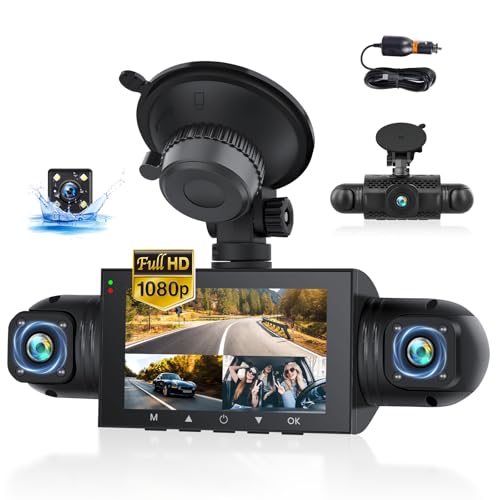If you’ve ever wondered how 360-degree cameras work on cars, you’re not alone. These cameras are becoming increasingly popular in modern vehicles, providing drivers with a complete view of their surroundings. From parking in tight spaces to navigating through busy intersections, 360-degree cameras can enhance driver awareness and safety on the road.

Understanding how these cameras work can be complex, but it’s worth taking the time to explore the technology. In this article, we’ll break down the basics of 360-degree cameras and how they function in a car’s design. We’ll also explore the different types of systems available, including manufacturer-specific options and aftermarket solutions for older vehicles.
By the end of this article, you’ll have a better understanding of how 360-degree cameras work and how they can benefit you as a driver. Whether you’re in the market for a new car or simply curious about the latest automotive technology, read on to learn more.
Key Takeaways
- 360-degree cameras provide drivers with a complete view of their surroundings, enhancing safety and awareness on the road.
- These cameras use multiple lenses and software to stitch together a composite image of a car’s surroundings, which is displayed on a screen in the vehicle.
- There are a variety of 360-degree camera systems available, including manufacturer-specific options and aftermarket solutions for older vehicles.
Understanding 360-Degree Camera Technology
https://www.youtube.com/watch?v=fdDZaH8hg1A&embed=true
If you are wondering how a 360-degree camera system works in a car, you have come to the right place. In this section, we will explain the components of the 360-degree camera system and how multiple cameras work together to provide a real-time view of your car’s surroundings.
Components of the 360-Degree Camera System
The 360-degree camera system consists of multiple cameras placed around the car, including the front, rear, and both sides. These cameras capture images of the car’s surroundings, which are then stitched together to create a single, seamless image. The dashboard or infotainment system display shows this stitched-together image, which provides a top view or surround view of your car.
In addition to the cameras, the 360-degree camera system also includes software that removes the distortion caused by the wide lens and cuts out the overlapping bits of the images. The software then stitches the images together to give you a crystal clear view of your car’s surroundings. Ultimately, the software displays a view of your car’s surroundings with a graphic of your car and gridlines.
How Multiple Cameras Work Together
The multiple cameras in a 360-degree camera system work together to provide a real-time view of the area surrounding your car. The cameras capture images of the car’s surroundings, which are then processed by the software to create a seamless, stitched-together image. This image is then displayed on the dashboard or infotainment system display, providing you with a top view or surround view of your car.
Each camera in the 360-degree camera system captures a different perspective of the car’s surroundings. The software then combines these perspectives to create a complete view of the area around your car. This allows you to see objects that may be out of view from a single camera, such as a curb or a small child.
In conclusion, the 360-degree camera system in a car provides you with a real-time view of the area surrounding your car. The system consists of multiple cameras placed around the car that capture images of the car’s surroundings. The images are then processed by software to create a seamless, stitched-together image that is displayed on the dashboard or infotainment system display. This technology is also known as a surround view or top view camera system.
Installation and Positioning of Cameras
https://www.youtube.com/watch?v=gkdTFsMK8FA&embed=true
Installing a 360 camera system on your car requires careful planning and proper positioning of the cameras. Here are some tips to help you with the installation process.
Front Grill and Rear Placement
« What is a 360 Camera and How Does It Work?
How Do 360 Cameras Work on Cars: A Beginner’s Guide »
The front grill and rear placement of the cameras are the most important positions to consider when installing a 360 camera system. The front grill camera should be mounted as low as possible to capture the ground view. This camera can be mounted on the front bumper, or on the grill itself. The rear camera should be mounted at the top of the rear window, or on the trunk lid. This camera captures the view of the rear of the vehicle, including the license plate.
Side Mirror Integration
Integrating the cameras with the side mirrors is another option to consider. This integration allows the cameras to be mounted discreetly and provides an unobstructed view of the sides of the vehicle. The cameras can be mounted on the side mirrors or on the door panels. This placement provides a clear view of the sides of the vehicle and eliminates blind spots.
When positioning the cameras, it is important to consider the field of view and the angle of the cameras. The cameras should be positioned to provide a complete 360-degree view of the surrounding area. Additionally, the cameras should be angled correctly to provide a clear view of the area around the vehicle.
Proper installation and positioning of the cameras are crucial for the 360 camera system to work effectively. By following these tips, you can ensure that your camera system provides a clear and complete view of your vehicle’s surroundings.
The Role of Software in 360 Camera Systems
https://www.youtube.com/watch?v=g4H8msSQhr0&embed=true
If you’ve ever wondered how 360-degree camera systems work in cars, the answer is software. The software is the linchpin of this technology and is responsible for seamlessly combining the images from the cameras, removing any distortion, and creating a cohesive and clear view on your infotainment screen.
Stitching Images for a Seamless View
To create a 360-degree view, the software stitches together images from multiple cameras placed around the car. These cameras capture images from different angles, which are then processed and combined to create a seamless view of your car’s surroundings. The software removes the distortion caused by the wide lens, cuts out the overlapping bits of the images, and stitches the images together to give you a crystal-clear view of your car’s surroundings.
Real-Time Processing
The software also enables real-time processing of the images, which is essential for providing you with a live view of your car’s surroundings. The software processes the images from the cameras in real-time, which means that you get a live view of your car’s surroundings on your infotainment screen. This real-time processing is crucial for providing you with the situational awareness you need to drive safely.
In summary, the software is the backbone of 360-degree camera systems in cars. It seamlessly combines the images from the cameras, removes any distortion, and creates a cohesive and clear view on your infotainment screen. This process ensures that blind spots are significantly reduced, empowering you with better situational awareness.
Manufacturer-Specific Systems
https://www.youtube.com/watch?v=XoJuOULM3Xg&embed=true
When it comes to 360 cameras in cars, different manufacturers have their own unique approaches. Here are some examples:
Ford’s Approach to 360 Cameras
Ford has a 360-degree camera system that uses four cameras to create a bird’s-eye view of the car. The cameras are located on the front grille, tailgate, and side mirrors. The system is called “Split View” and is available on select Ford models. With Split View, you can see all around the car, which makes parking and maneuvering in tight spaces much easier.
Nissan’s Around View Monitor
Nissan has a system called “Around View Monitor” that uses four cameras to create a 360-degree view of the car. The cameras are located on the front grille, tailgate, and side mirrors. The system is available on select Nissan models. With Around View Monitor, you can see all around the car, which makes parking and maneuvering in tight spaces much easier.
Other manufacturers like Toyota, Hyundai, Audi, Chevrolet, and Mercedes-Benz also have their own unique approaches to 360 cameras in cars. However, the specifics of their systems may vary.
Enhancing Driver Awareness and Safety
https://www.youtube.com/watch?v=OpPpbE_udss&embed=true
Driving can be a stressful experience, especially in heavy traffic or tight parking spaces. However, modern cars are equipped with advanced technology that can help you navigate these situations with ease. One such technology is the 360-degree camera system, which enhances driver awareness and safety in several ways.
Reducing Blind Spots
Blind spots are areas around your car that you cannot see in your mirrors or through your windows. These can be particularly dangerous when changing lanes or merging into traffic. However, 360-degree cameras can help eliminate blind spots by providing a complete view of your surroundings. With this technology, you can see everything around your car, including objects that may be hidden from your mirrors or windows.
Parking Assistance Features
Parking can be a challenging task, especially in tight spaces. However, 360-degree cameras can make parking a breeze by providing a bird’s eye view of your surroundings. This allows you to see exactly where your car is in relation to other objects, making it easier to park safely and accurately. Some systems even include parking assist features that can guide you into a parking spot automatically.
In addition to reducing blind spots and assisting with parking, 360-degree cameras are also an important safety feature. They can help you avoid collisions with other vehicles, pedestrians, or objects in your path. With this technology, you can drive with confidence, knowing that you have a complete view of your surroundings.
Overall, 360-degree cameras are an essential technology for modern cars. They enhance driver awareness and safety, reduce blind spots, and assist with parking. If you’re in the market for a new car, be sure to look for one that includes this advanced technology.
Convenience and Utility for Drivers
https://www.youtube.com/watch?v=X38sjawXo0I&embed=true
Having a 360-degree camera in your car brings a lot of convenience and utility to your driving experience. It makes your life easier by providing you with a bird’s-eye view of your surroundings, giving you a better sense of the space around your car. Here are some of the ways in which a 360-degree camera can aid you while driving.
Easing the Challenges of Parallel Parking
Parallel parking can be a daunting task, especially if you’re not used to it. With a 360-degree camera, you can easily navigate your way into tight spots without the fear of hitting another car or scraping the curb. The camera provides a clear view of the space around your car, making it easier for you to judge your distance from other objects.
Aiding in Off-Road Maneuvers
Off-road driving can be tricky, especially when you have to navigate through narrow trails or steep inclines. With a 360-degree camera, you can get a better sense of your surroundings and make more informed decisions about your route. The camera can help you avoid obstacles that might not be visible from the driver’s seat, such as rocks, ditches, or fallen trees.
In summary, a 360-degree camera is a valuable tool for any driver. It provides convenience and utility by helping you park more easily and navigate through challenging off-road terrain. With a clear view of your surroundings, you can drive more confidently and safely.
Innovations and Advanced Features
https://www.youtube.com/watch?v=xqWkJJOcU4g&embed=true
Bird’s Eye View Capabilities
One of the most impressive innovations of 360-degree cameras in cars is their bird’s eye view capabilities. This feature provides you with a complete view of your car and its surroundings from above, giving you a better understanding of your surroundings. With this feature, you can easily navigate through tight spaces, park your car with ease and avoid obstacles in your way.
The bird’s eye view is made possible by the use of multiple cameras placed around the car, which capture images from different angles. These images are then combined to create a seamless, top-down view of your car and its surroundings. The view is often displayed on the car’s infotainment screen, allowing you to see a clear and detailed picture of your car’s surroundings.
Advanced Driver Assistance Systems Integration
360-degree cameras are often integrated with advanced driver assistance systems (ADAS) to provide you with a safer and more comfortable driving experience. For example, blind spot detection is a common feature that uses the 360-degree camera to detect objects in your blind spots. This feature alerts you when you’re about to change lanes and there’s a vehicle in your blind spot.
Another example of ADAS integration is automatic parking. With the help of the 360-degree camera, your car can park itself in tight spaces without any input from you. This feature is especially useful in crowded urban areas where parking can be a challenge.
In addition to these features, 360-degree cameras can also be integrated with other ADAS features such as lane departure warning, collision warning, and adaptive cruise control. These features work together to provide you with a safer and more comfortable driving experience.
Overall, the bird’s eye view capabilities and ADAS integration are just a few of the many innovations and advanced features that make 360-degree cameras in cars a must-have for any driver.
Aftermarket Options for Older Vehicles
https://www.youtube.com/watch?v=0uqX6cSEFu4&embed=true
If your older vehicle doesn’t have a 360-degree camera, you might be interested in installing an aftermarket kit. These kits are available for most vehicles and can be a great way to add an extra layer of safety to your driving experience. In this section, we’ll cover some things to consider when choosing an aftermarket 360 camera kit and how to install it.
Choosing an Aftermarket 360 Camera Kit
When choosing an aftermarket kit, you’ll want to consider a few things. First, you’ll want to make sure the kit is compatible with your vehicle. Some kits are designed specifically for certain makes and models, while others are more universal. Check the product description and specifications to make sure the kit will work with your vehicle.
Next, consider the quality of the product. Look for kits with high-resolution cameras and good image processing software. You’ll want to be able to see a clear, detailed view of your surroundings. Some kits also come with additional features, such as night vision or parking guidelines.
Finally, consider the price. Aftermarket kits can range from a few hundred to several thousand dollars. While a more expensive kit might have better features, it might not be worth the extra cost if you don’t plan on using those features.
Installation and Compatibility Considerations
Installing an aftermarket 360 camera kit can be a bit tricky, especially if you’re not familiar with car electronics. Some kits require professional installation, while others can be installed at home with a bit of DIY knowledge.
Before purchasing a kit, make sure you understand the installation process. Some kits require wiring to be run through your vehicle, which can be difficult and time-consuming. Others simply plug into your existing backup camera system.
You’ll also want to make sure the kit is compatible with your vehicle’s electronics. Some older vehicles might not have the necessary wiring or software to support a 360 camera system. Check the product specifications and consult with a professional if you’re unsure.
Overall, an aftermarket 360 camera kit can be a great way to add an extra layer of safety to your older vehicle. Just make sure you choose a quality product that’s compatible with your vehicle and understand the installation process before making a purchase.
The Impact of 360 Cameras on Vehicle Design

Aesthetic Integration Into Modern Vehicles
360 cameras have had a significant impact on the design of modern vehicles. These cameras are now an essential feature of many new cars, and as such, automakers have had to integrate them seamlessly into the overall design of their vehicles.
One of the most significant challenges automakers face when integrating 360 cameras into their designs is ensuring that the cameras do not detract from the overall aesthetic of the vehicle. To achieve this, automakers have had to carefully consider the placement of the cameras and the materials used to house them.
For example, many automakers have opted to integrate the cameras into the bodywork of the vehicle, rather than mounting them on top of the vehicle like traditional cameras. This approach not only helps to maintain the vehicle’s aesthetic but also provides better visibility for the cameras.
Influence on Automaker Branding
The integration of 360 cameras into modern vehicles has also had a significant impact on automaker branding. As these cameras become more prevalent, automakers have had to find new ways to differentiate themselves from their competitors.
One way automakers have done this is by offering unique camera features that are not available on other vehicles. For example, some automakers have developed 360 cameras that can be used to create a virtual bird’s eye view of the vehicle, while others have developed cameras that can be used to create a 3D model of the vehicle’s surroundings.
These unique camera features not only help to differentiate automakers from their competitors but also provide consumers with new and exciting ways to interact with their vehicles.
In conclusion, the integration of 360 cameras into modern vehicles has had a significant impact on vehicle design and automaker branding. Automakers have had to carefully consider the placement of these cameras to ensure they do not detract from the overall aesthetic of the vehicle, while also finding new and unique ways to differentiate themselves from their competitors.
Consumer Considerations
https://www.youtube.com/watch?v=1NxVisZKYEA&embed=true
When considering purchasing a car equipped with a 360-degree camera, there are a few important factors to take into account. Here are some key points to keep in mind:
Cost-Benefit Analysis
Before investing in a 360-degree camera system for your car, it’s important to weigh the costs and benefits. While these cameras can be incredibly useful, they can also be quite expensive. Consider your budget and how much you’re willing to spend on this feature. Additionally, think about how often you’ll actually use the camera. If you frequently park in tight spaces or navigate crowded areas, it may be worth the investment. However, if you rarely find yourself in these situations, you may be better off saving your money.
Evaluating User Reviews and Feedback
When considering a 360-degree camera system, it’s important to read user reviews and feedback. Look for reviews from people who have actually used the system in real-world situations. This can give you a better idea of how useful the system is and how well it works. Additionally, pay attention to any common complaints or issues that users have reported. This can help you make an informed decision about whether or not the system is right for you.
Overall, a 360-degree camera system can be a useful feature for many drivers. However, it’s important to carefully consider the cost and benefits before making a purchase. Additionally, be sure to read user reviews and feedback to get a better idea of how well the system works in real-world situations.
Frequently Asked Questions
https://www.youtube.com/watch?v=Qn2aewGU3mY&embed=true
What are the benefits of having a 360-degree camera in a car?
A 360-degree camera system provides a bird’s eye view of the surroundings of a car. This feature helps drivers to park and maneuver in tight spaces with ease. It also reduces the risk of accidents caused by blind spots. With a 360-degree camera, you can see everything around your car, including pedestrians, cyclists, and other vehicles.
Can you explain the bird’s eye view feature in car cameras?
The bird’s eye view feature in car cameras is a composite of camera angles from several locations around the vehicle. The images from these cameras are stitched together to create a 360-degree view of the car’s surroundings. The image projected on your vehicle’s display screen is much like one a drone or blimp would capture. This view allows you to see the car from all angles, making it easier to park and maneuver in tight spaces.
What should I consider when looking for a 360 camera installation service?
When looking for a 360 camera installation service, you should consider the experience and expertise of the installer. The installer should have a good understanding of the camera system and be able to install it correctly. You should also consider the quality of the cameras and the display screen. Look for a system that provides high-resolution images and a clear display.
How do 360 cameras enhance the experience of car racing?
360 cameras can enhance the experience of car racing by providing a complete view of the track. With a 360 camera, you can see the entire track and all the cars around you. This feature helps you to make better decisions while racing and reduces the risk of accidents. It also provides a more immersive experience for the driver.
What’s the typical cost range for installing a 360 camera system in a vehicle?
The cost of installing a 360 camera system in a vehicle varies depending on the quality of the cameras and the complexity of the installation. On average, the cost ranges from $500 to $1500. However, it’s important to note that the cost can be higher for luxury vehicles or for more complex installations.
Where are 360 cameras typically mounted for the best coverage around a car?
360 cameras are typically mounted in strategic points around the car to provide the best coverage. These points include the front grille, under the side mirrors, and the rear end of the car. The cameras should be mounted in a way that provides a clear view of the surroundings and minimizes blind spots.















